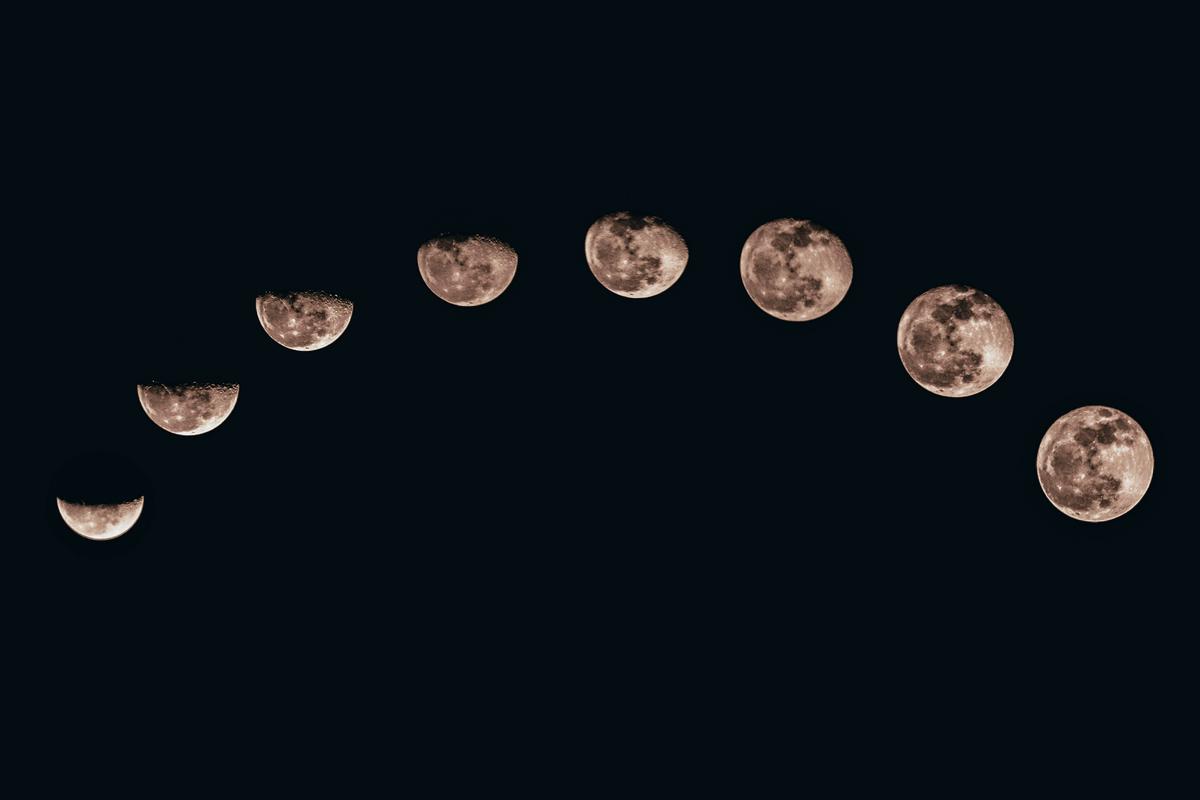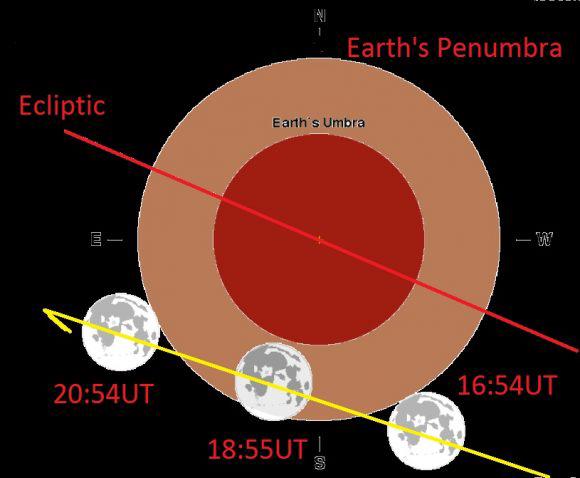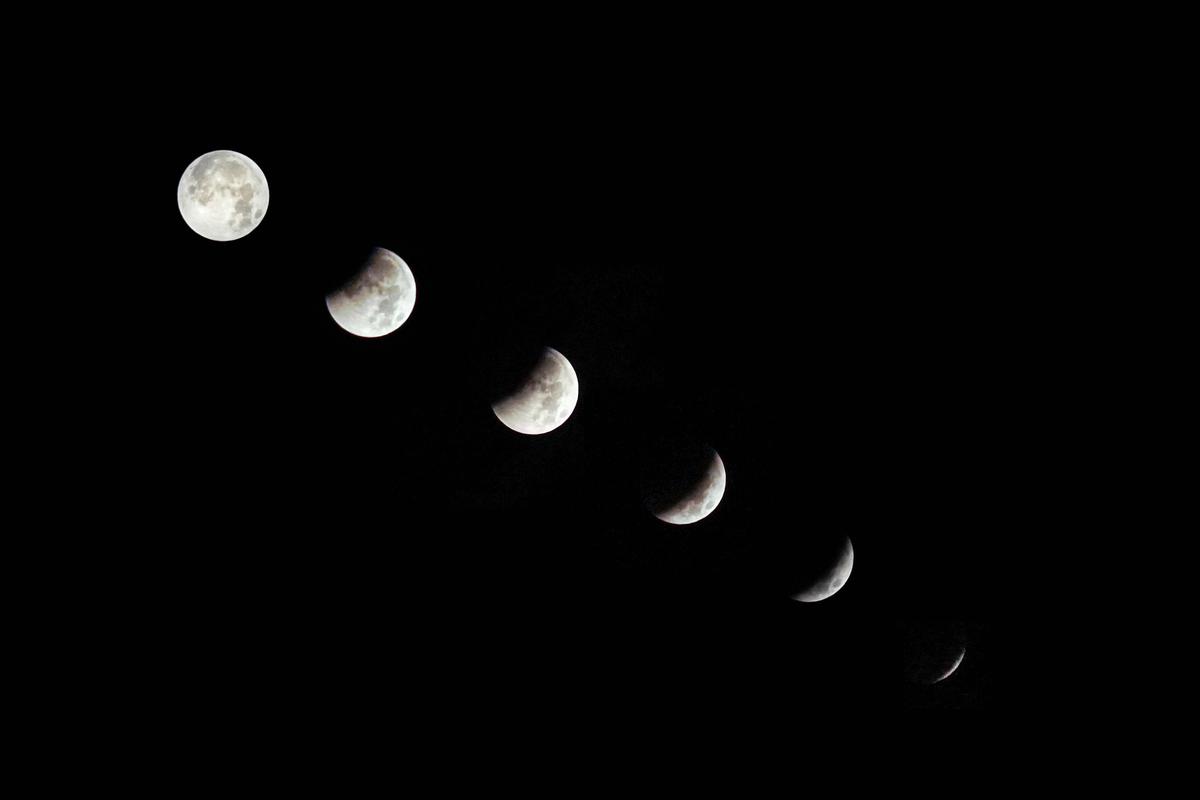Understanding Lunar Phases
The Moon's cyclical dance through its phases is driven by the celestial alignment of the Sun, Earth, and Moon. As Earth's sole natural satellite orbits, its appearance from Earth changes due to the varying angles of sunlight that strike its surface. In each lunar month—approximately 29.53 days—the Moon undergoes eight distinct phases.
Starting with the New Moon, the lunar surface is unseen from our vantage point. As it proceeds, a sliver of illumination peeks, incrementally unveiling more of the Moon in the Waxing Crescent. The First Quarter phase is a halfway mark where precisely 50% of the Moon's face is sunlit. The Waxing Gibbous follows, revealing more than half of the moon's face.
The Full Moon occurs when the Moon is completely opposed to the Sun, with its entire visible surface illuminated. Subsequent stages embody a diminishment of illumination; the Waning Gibbous phase starts trimming the brightly lit spectacle. The Third Quarter marks another halving of visibility, with the sunlit part decreasing. Illumination wanes further through the Waning Crescent before reverting to another New Moon.
Each phase dictates the Moon's visibility and the time it's likely to rise and set. Especially during the New and Full Moons, tides are enhanced due to the combined gravitational pull of the Moon and the Sun aligning with Earth.
Understanding these lunar phases enriches our engagement with the night sky, bridging ancient human observations with modern scientific descriptions. The distinctive, predictable pattern of moonrise and moonset times tied to each phase has influenced timekeeping, navigation, and cultural practices across history.1

Photo by sannisahil on Unsplash
Lunar Phases and Their Impact
The lunar phases exert tangible effects on various terrestrial phenomena. The gravitational forces exercised by the Moon and the Sun largely dictate the ebb and flow of oceanic tides. During both the New Moon and Full Moon phases, when the Earth, Moon, and Sun align, the tidal forces amplify, producing spring tides. These tides are characterized by higher high waters and lower low waters. Conversely, during the Quarter phases, the reduced gravitational pull results in neap tides with minimal tide fluctuation.2
The impact of the Moon extends into ecological behavioral patterns:
- The oviposition cycle of corals tends to occur immediately after the Full Moon, with the increased illumination potentially serving as a trigger for synchronized spawning events.
- Terrestrial wildlife is also influenced, with studies suggesting that predator-prey dynamics shift with the lunar phases. The increased brightness during the Full Moon empowers predators with better visibility to hunt but also exposes them and their prey to higher risk of detection.
Agricultural practices have been influenced by lunar cycles as well. Biodynamic farming takes into account the timing of planting, harvesting, and pruning based on specific phases. Root crops are often planted during the waning moon when soil moisture is deemed most suitable.
The pervasive influence of the lunar cycle is evident in countless folklore and cultural practices that ascribe distinct qualities to different phases of the Moon. Whether steering agricultural activities or comprehending tidal manipulations, lunar phases remain a wellspring of scientific study and cultural significance.
Moon Phases and Eclipses
Solar and lunar eclipses occur under specific conditions when the Sun, Earth, and Moon align in a precise celestial choreography. Lunar eclipses happen during the Full Moon phase when Earth positions itself between the Sun and the Moon. As the Moon orbits Earth, it moves into Earth's shadow, which is composed of the penumbra (outer part) and the umbra (inner, darker part). A total lunar eclipse unfolds when the Moon traverses entirely within Earth's umbral shadow, revealing a "blood moon" tinged ruddy-orange. In partial lunar eclipses, only a segment of the Moon passes through the umbra, while penumbral lunar eclipses involve only the fainter shadow.
Solar eclipses occur during the New Moon phase when the Moon is between Earth and the Sun, casting a shadow over Earth. The umbral shadow can cause a total or annular eclipse, while the penumbral shadow results in a partial eclipse. A total solar eclipse occurs when the Moon completely obscures the Sun, revealing the solar corona. An annular eclipse, or "ring of fire," happens when the Moon appears smaller than the Sun, leaving a rim of light encircling its shadow. In regions where only the penumbral shadow sweeps, observers witness a partial eclipse.
Understanding the interplay between lunar phases and eclipses underscores the precise nature of these cosmic events and the awe-inspiring sights they afford. By aligning our knowledge with these celestial mechanics, we heighten our appreciation for the grand ballet of our universe.

Practical Applications of Lunar Calendars
Lunar calendars have long been woven into various cultural practices, from agriculture to religious observances and astrological traditions. In agricultural contexts, many cultures rely on lunar phases to guide the best times to sow and harvest crops. The waxing moon is often associated with plant growth, making it a preferred time for planting above-ground crops. Root vegetables are commonly planted during the waning moon when soil moisture retention is higher.
Religious observances frequently depend on lunar calendars. Many major religious festivals, such as Ramadan in Islam and Diwali in Hinduism, are timed according to the phases of the moon. These festivals mark spiritual milestones and reinforce communal bonds through their alignment with lunar phases.
Astrological practices across various cultures display a robust connection with lunar calendars. The moon's position relative to zodiac constellations is considered pivotal and influences horoscopes in Western, Chinese, Vedic, and Babylonian astrological traditions.
Lunar calendars are also crucial in predicting tidal behaviors, which is invaluable for coastal navigation, fishing schedules, and marine conservation efforts. The gravitational tug between the Earth and Moon, peaking during new and full moons, causes significant tidal changes known as spring tides.3
As our understanding of the cosmos deepens, the practical applications of lunar calendars remain profound across diverse human activities. Whether directing agricultural practices, guiding religious observances, informing astrological predictions, or managing marine activities, the moon's phases serve as a reliable schedule deeply entrenched in both our past and present.
The Moon's phases profoundly influence terrestrial and human activities. By understanding these phases, we gain insights into environmental rhythms and our historical and cultural connections to this celestial neighbor. The lunar cycle remains a captivating subject of scientific study and cultural significance, highlighting our enduring fascination with the moon and its impact on our world.
- Kelley DH, Milone EF. Exploring Ancient Skies: A Survey of Ancient and Cultural Astronomy. 2nd ed. New York, NY: Springer; 2011.
- Kvale EP, Archer AW, Johnson HR. Daily, monthly, and yearly tidal cycles within laminated siltstones of the Mansfield Formation (Pennsylvanian) of Indiana. Geology. 1995;23(4):365-368.
- Barnett-Johnson R, Pearson TE, Ramos FC, Grimes CB, MacFarlane RB. Tracking natal origins of salmon using isotopes, otoliths, and landscape geology. Limnology and Oceanography. 2008;53(4):1633-1642.
![]()
